Spring is in full swing, with summer fast approaching. This means that flowers are on every corner, freshly cut on most tables, and possibly blossoming in your own garden. If you’re partaking in this extravaganza, more flower power to you. Be aware, however, that if you’ve got a furry feline that is fairly curious (read: all of them), there are some plants and flowers that are toxic or at least potentially toxic to cats. We’ve listed 10 of them below so you know what you can buy for optimal cat wellness and what to leave for other, non-cat households. If you'd like a full list of plants that are poisonous or potentially poisonous to cats, please see this guide of toxic plants to cats put out by the ASPCA.
1. Lilies
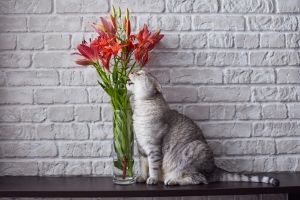
This beautiful unofficial symbol of Spring is among the most toxic flowers to cats. All varieties - including the Easter, Tiger, Stargazer, Red, Wood, and Day - are unsafe. With some flowers, the petals and the buds are the hazards for cats but, with lilies, it’s also the pollen, the leaves, and the stems. As veterinarians will warn, even having a cat take a tiny sip of water from a vase of lilies can cause kidney failure.
Symptoms of Lily Poisoning:
- Lethargy
- Vomiting
- Diarrhea
- Seizures
2. Azaleas
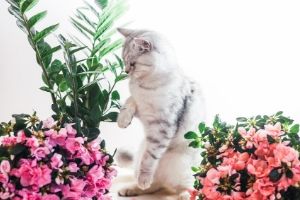
Although this member of the Rhododendron family is only moderately toxic to cats, it is still advised to keep your cats away, as many cats have a tendency to want to nibble on them. All parts of the plants can cause sickness but not likely to the level of clinical toxicosis.
Symptoms of Azalea Poisoning:
- Vomiting
- Diarrhea
- Hypersalivation
- Weakness
- Coma
- Hypotension
- Central nervous system (CNS) depression
- Cardiovascular collapse
3. Birds of Paradise

This stunning and exotic-looking plant is somewhat mild in toxicity but, again, it’s best to keep those furry felines away. Its flower seeds contain tannins that are toxic as well as leaves that contain hydrocyanic acid.
Symptoms of Birds of Paradise Poisoning:
- Digestive issues
- Labored breathing
- Eye discharge
4. Irises
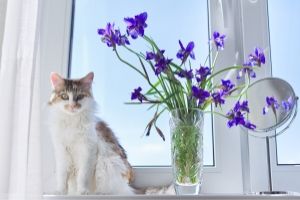
If you’ve got a friend who regularly has fresh flowers in a vase, chances are it is at least partially filled with these lovely, ruffled flowers. Although not very toxic, they can cause extreme discomfort in your cat and can result in more serious problems if left untreated. Although all parts of the plant are dangerous to cats, it’s the bulbs that can cause the most problems.
Symptoms of Iris Poisoning:
- Abdominal pain
- Skin irritation (Dermatitis)
- Diarrhea
- Nausea and vomiting
- Ulcers of the mouth
5. Dahlias
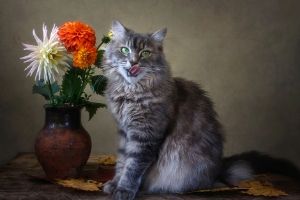
These bushy, beautiful flowers are a favorite among plant enthusiasts but they’re also unfortunately fairly toxic to cats.
Symptoms of Dahlia Poisoning:
- Dermatitis
- Gastrointestinal issues
6. Hydrangeas

A common flower in many arrangements sold at grocery stores because of their gorgeous colors and pretty petals, hydrangeas are poisonous to cats and other animals. Hydrangeas have metabolites within them, and these are the toxic elements. And although all parts of this plant are toxic, it’s the flowers and the leaves that can cause the most damage, so vets recommend you call them right away if you’ve noticed your pet taking a nibble (even if symptoms haven’t shown up yet).
Symptoms of Hydrangea Poisoning:
- Diarrhea
- Exhaustion
- Depression
- Vomiting
7. Lily of the Valley Plants
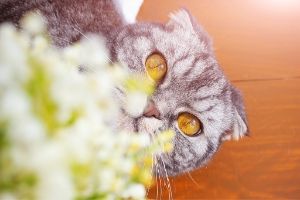
Looking at the petite petals on this overall dainty looking plant, you wouldn’t guess the powerfully toxic punch it packs. Although it is different than the previously mentioned species of Lily and does not result in acute kidney failure, it is still quite poisonous and requires quick action on your part if you catch your favorite furry friend partaking in a Lily of the Valley snack.
Symptoms of Lily of the Valley Poisoning:
- Vomiting
- Diarrhea
- Possible seizures
- A sudden drop in heart rate
- Severe cardiac arrhythmias
8. Chrysanthemums

Another vibrant flower you’ve surely seen on your quarantine-inspired walks, Chrysanthemums are mildly toxic to cats. What’s interesting is that they contain pyrethrins, which is an ingredient in many dog flea and tick medications that is particularly poisonous to cats.
Symptoms of Chrysanthemum Poisoning:
- Diarrhea
- Vomiting
- Appetite loss
9. Tulips

Say it ain’t so! We know, we know—tulips are a favorite and staple around this time of year. In fact, tulips are second only to roses as the country’s most popular flower. Unfortunately, these favored flowers have parts that are all toxic to cats, with the bulbs being the most dangerous part.
Symptoms of Tulip Poisoning:
- Vomiting
- Diarrhea
- Depression
10. Hyacinths

These gorgeous house flowering plants are as fragrant as they are gorgeous, and they come in deep purples, pinks, whites, yellows, reds, blues, apricots, and lavenders. Unfortunately, these dense and tall flowers can be toxic to cats, even from inhaling them!
Symptoms of Hyacinth Poisoning:
- Lethargy
- Decreased appetite
- Vomiting and diarrhea, sometimes containing blood
- GI irritation
- Colic Weakness
- Drooling in the case of ingestion
- In severe cases: tremors, breathing difficulties, depression
We know that flowers can be a huge source of happiness, but the health of your cat is a top priority, too. As mentioned, the key to caring for your curious cat in the case of possible poisoning is swift action in calling poison control and contacting your family veterinarian or the nearest emergency clinic.
